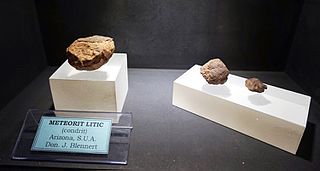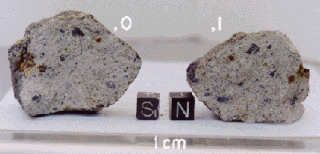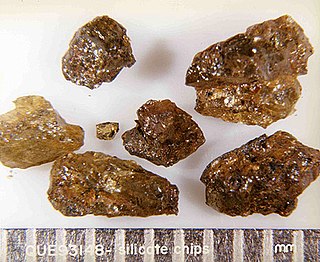Related Research Articles

A meteorite is a solid piece of debris from an object, such as a comet, asteroid, or meteoroid, that originates in outer space and survives its passage through the atmosphere to reach the surface of a planet or moon. When the original object enters the atmosphere, various factors such as friction, pressure, and chemical interactions with the atmospheric gases cause it to heat up and radiate energy. It then becomes a meteor and forms a fireball, also known as a shooting star; astronomers call the brightest examples "bolides". Once it settles on the larger body's surface, the meteor becomes a meteorite. Meteorites vary greatly in size. For geologists, a bolide is a meteorite large enough to create an impact crater.

In meteoritics, a meteorite classification system attempts to group similar meteorites and allows scientists to communicate with a standardized terminology when discussing them. Meteorites are classified according to a variety of characteristics, especially mineralogical, petrological, chemical, and isotopic properties.

A chondrite is a stony (non-metallic) meteorite that has not been modified, by either melting or differentiation of the parent body. They are formed when various types of dust and small grains in the early Solar System accreted to form primitive asteroids. Some such bodies that are captured in the planet's gravity well become the most common type of meteorite by arriving on a trajectory toward the planet's surface. Estimates for their contribution to the total meteorite population vary between 85.7% and 86.2%.

An achondrite is a stony meteorite that does not contain chondrules. It consists of material similar to terrestrial basalts or plutonic rocks and has been differentiated and reprocessed to a lesser or greater degree due to melting and recrystallization on or within meteorite parent bodies. As a result, achondrites have distinct textures and mineralogies indicative of igneous processes.

A micrometeorite is a micrometeoroid that has survived entry through the Earth's atmosphere. Usually found on Earth's surface, micrometeorites differ from meteorites in that they are smaller in size, more abundant, and different in composition. The IAU officially defines meteoroids as 30 micrometers to 1 meter; micrometeorites are the small end of the range (~submillimeter). They are a subset of cosmic dust, which also includes the smaller interplanetary dust particles (IDPs).

Carbonaceous chondrites or C chondrites are a class of chondritic meteorites comprising at least 8 known groups and many ungrouped meteorites. They include some of the most primitive known meteorites. The C chondrites represent only a small proportion (4.6%) of meteorite falls.

Meteoric iron, sometimes meteoritic iron, is a native metal and early-universe protoplanetary-disk remnant found in meteorites and made from the elements iron and nickel, mainly in the form of the mineral phases kamacite and taenite. Meteoric iron makes up the bulk of iron meteorites but is also found in other meteorites. Apart from minor amounts of telluric iron, meteoric iron is the only naturally occurring native metal of the element iron on the Earth's surface.

HED meteorites are a clan (subgroup) of achondrite meteorites. HED stands for "howardite–eucrite–diogenite". These achondrites came from a differentiated parent body and experienced extensive igneous processing not much different from the magmatic rocks found on Earth and for this reason they closely resemble terrestrial igneous rocks.

The Tagish Lake meteorite fell at 16:43 UTC on 18 January 2000 in the Tagish Lake area in northwestern British Columbia, Canada.
Keilite is an iron-magnesium sulfide mineral with the chemical formula (Fe,Mg)S) that is found in enstatite chondrites. Keilite is the iron-dominant analog of niningerite. Keilite is named after Klaus Keil.

Mbozi is an ungrouped iron meteorite found in Tanzania. It is one of the world's largest meteorites, variously estimated as the fourth-largest to the eighth-largest, it is located near the city of Mbeya in Tanzania's southern highlands. The meteorite is 3 metres (9.8 ft) long, 1 metre high, and weighs an estimated 16 metric tons.
CI chondrites, also called C1 chondrites or Ivuna-type carbonaceous chondrites, are a group of rare carbonaceous chondrite, a type of stony meteorite. They are named after the Ivuna meteorite, the type specimen. CI chondrites have been recovered in France, Canada, India, and Tanzania. Their overall chemical composition closely resembles the elemental composition of the Sun, more so than any other type of meteorite.

Lodranites are a small group of primitive achondrite meteorites that consists of meteoric iron and silicate minerals. Olivine and pyroxene make up most of the silicate minerals. Like all primitive achondrites lodranites share similarities with chondrites and achondrites.
Winonaites are a group of primitive achondrite meteorites. Like all primitive achondrites, winonaites share similarities with chondrites and achondrites. They show signs of metamorphism, partial melting, brecciation and relic chondrules. Their chemical and mineralogical composition lies between H and E chondrites.

IAB meteorites are a group of iron meteorites according to their overall composition and a group of primitive achondrites because of silicate inclusions that show a strong affinity to winonaites and chondrites.

The Zakłodzie meteorite is a stony-iron meteorite found in Poland in 1998. Its mass is 8.68 kilograms (19.1 lb). It is composed predominantly from enstatite and meteoric iron. Currently classified as an ungrouped enstatite achondrite its classification is still an ongoing scientific debate.
This is a glossary of terms used in meteoritics, the science of meteorites.
CM chondrites are a group of chondritic meteorites which resemble their type specimen, the Mighei meteorite. The CM is the most commonly recovered group of the 'carbonaceous chondrite' class of meteorites, though all are rarer in collections than ordinary chondrites.
Gas-rich meteorites are meteorites with high levels of primordial gases, such as helium, neon, argon, krypton, xenon and sometimes other elements. Though these gases are present "in virtually all meteorites," the Fayetteville meteorite has ~2,000,000 x10−8 ccSTP/g helium, or ~2% helium by volume equivalent. In comparison, background level is a few ppm.
Christine Floss (1961–2018) was a German-born American cosmochemist whose research involved studying the atomic composition of meteorites, interplanetary dust, and moon rocks in order to understand the formation of the Solar System. She was a research professor of physics at Washington University in St. Louis, affiliated with the university's Laboratory for Space Sciences and McDonnell Center for the Space Sciences.
References
- ↑ Keil, Klaus (31 December 2009). "Enstatite achondrite meteorites (aubrites) and the histories of their asteroidal parent bodies". Chemie der Erde - Geochemistry. 70 (4): 295–317. Bibcode:2010ChEG...70..295K. doi:10.1016/j.chemer.2010.02.002.
- 1 2 3 4 5 "Itqiy". Meteoritical Society.
- 1 2 3 4 5 6 7 8 "Itqiy". Meteoritical Society . Retrieved 21 December 2012.
- ↑ "EH7-an". Meteoritical Society.
- ↑ Grossman, Jeffrey N.; Jutta Zipfel (2001). "The Meteoritical Bulletin, No. 85, 2001 September" (PDF). Meteoritics & Planetary Science. 36 (S9): A293–A322. Bibcode:2001M&PS...36..293G. doi: 10.1111/j.1945-5100.2001.tb01542.x . Retrieved 21 December 2012.
- ↑ Patzer, Andrea; Dolores Hill; William Boynton; Luitgard Franke; Ludolf Schultz; Timothy Jull; Lanny McHargue; Ian Franchi (2010). "Itqiy: A study of noble gases and oxygen isotopes including its terrestrial age and a comparison with Zakłodzie". Meteoritics & Planetary Science. 37 (6): 823–833. doi: 10.1111/j.1945-5100.2002.tb00858.x .
- 1 2 Patzer, Andrea; Hill, Dolores H.; Boynton, William V. (1 November 2001). "Itqiy: A metal-rich enstatite meteorite with achondritic texture". Meteoritics & Planetary Science. 36 (11): 1495–1505. Bibcode:2001M&PS...36.1495P. doi: 10.1111/j.1945-5100.2001.tb01841.x .
- 1 2 Keil, Klaus (2010). "Enstatite achondrite meteorites (aubrites) and the histories of their asteroidal parent bodies". Chemie der Erde - Geochemistry. 70 (4): 295–317. Bibcode:2010ChEG...70..295K. doi:10.1016/j.chemer.2010.02.002.
- ↑ IZAWA, Matthew R. M.; FLEMMING, Roberta L.; BANERJEE, Neil R.; MATVEEV, Sergei (1 November 2011). "QUE 94204: A primitive enstatite achondrite produced by the partial melting of an E chondrite-like protolith". Meteoritics & Planetary Science. 46 (11): 1742–1753. Bibcode:2011M&PS...46.1742I. doi: 10.1111/j.1945-5100.2011.01263.x .